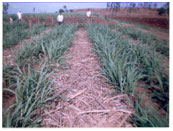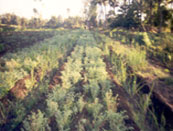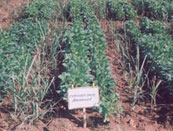
|
||||||||||||||||||||||||||||||||||||||||||||||||||||||||||||||||
|
Sugarcane Agronomy
The sugarcane deals with cultivation aspects of sugarcane including its supporting sections of soil science, crop physiology, agro-climate, varietal planting and harvesting seasons, mechanical harvesting .The important aspects of crop production issues are covered in this chapter.
Seed bed preparation
The field must be brought in such a tilth, which can ensure proper development and functioning of good root system. Formerly the soil was ploughed and harrowed many times to bring about very fine tilth but under present concept the old method is wasteful and costly. Presently we believe in minimum tillage because we have less time gap between to successive crops and a very fine tilth is not needed . Moreover, the land preparation is governed by the method of sowing to be adopted. Keeping all in mind one deep ploughing by mould board plough followed by two-three shallow ploughing or harrowing and cross planking is sufficient to keep down the weeds, to provide better aeration, to preserve moisture, to incorporate and help in decomposing organic matter into the soil etc. The heavy soils need more number of ploughings unlike light soils. METHODS OF PLANTING : 1. Planting in flat beds. Low rainfall areas generally opt this planting method, which is simplest as well as cheapest of all. In this method the furrows of about 40-50 cm depth are opened by the help of double mould board plough or furrowers at 90 cm distance wherein the seed-pieces are placed followed by planking for a better seed soil contact. Two blind hoeings are given to replace the insect damaged setts. After germination, two to five inter row cultures may be given at proper intervals to control the weeds and to facilitate the tillering. Generally, earthing is not done but some times, if it is necessary the crop may be given one earthing during July-August to protect the crop from lodging and to provide drainage in the field. 2. Ridge and furrow method. The method is generally adopted in areas with moderate rainfall but have drainage problems. The furrows are made in ‘v’ shape about 90 cm. Apart and about 20-25 cm deep. The setts are placed in horizontal position, usually in end-to-end system but if the seed stalk is not good and inter-nodes are longer eye-to-eye system of planting setts may be done. To minimize the border effects of gappiness, doubling of setts is done at the ends of the furrows. As the canes start growing, the furrows are partly filled with soil and inter-row cultivation is carried out. This repeated inter-row cultivation results in leveling of the land by end of May or Mid of June which is called as first earthing. Further repetition of inter-row cultivation transforms the furrow into ridges by putting soil around the plants and inter-row space become furrow automatically, through which irrigation or drainage is provided. This transformation of furrows into ridges is called as second earthing. 3. Trench method or Java method. This method is commonly practiced in Java.In this method the land is poughed and trenches are made about 1 meter apart with 20-30 cm depth and the soil taken out from trenches is put in the inter-row spaces. The trenches are given “U” shape and the soil at the bottom of the trenches is stirred up and mixed with manures making them ready for planting. The setts are placed now in horizontal position, as in the previous two methods by putting them either in end-to-end system or eye-to-eye system depending upon the type of seed stalk. The cane planter developed by Indian Institute of Sugarcane Research (IISR), Lucknow can be used which combines the operations of opening the furrows, placement of the fertilizers and then planting the setts in the rows. This planter can be used in all above-mentioned methods because it does the job quickly with minimum possible cost. 4. Rayungan method. Seed stalks are decapitated (topped off) about 4-6 weeks before the planting time. When, as a consequence, lateral shoots develop into tailed Rayungan they are cut off and planted out in the trenches made ready. Thus, by removing the upper rayungans, the lower buds are made to sprout and they are also similarly used. The trenches with 30 cm depth are made 90 cm apart and the soil is put in the inter-row spaces at the time of detopping the standing canes (seed stalks). The button of the trenches is stirred up to next 15 cm depth and the manures are mixed in this soil. The trenches are irrigated and the soil of the trench is mixed at 2-3 times before planting the setts (in vertical position 40-50 cm apart). The fertilizer is applied, the trenches are irrigated after putting back soil into them and the branched rayungans are cut off and pressed vertically into these trenches. At least 2-3 nodes must be underground to develop an effective rooting system. 5. Distant planting method. In this method the top setts are collected and put in nursery and after they have sprouted and rooted out they are transplanted in the final field at a spacing of 90 cm x 50 cm.    6 Tjeblock method. Tjeblock method is an improvement over the rayungan method because it takes care of proper availability of energy and nutrient to all the buds, whereas in rayungan method there is a considerable stress of nutrient supply on lower buds. In Tjeblock method the stalk is cut off at its half length and planted vertically with one node under the soil for rooting. The planted ones and the mother stalks are adequately irrigated and fertilized. Now the upper buds of both Tjeblocks and mother cane, which sprout in due course of time, are planted by cutting them into setts, as rayungans. 7. Bud transplanting. Sugarcane buds with half of its stalk can be planted in small polythene sleeves (which are filled with leaf mould and soil) and after they have sprouted out they can be transplanted in the final field along with the polythene bag (opened at bottom). The seedling mortality has been found to about 5%. This is modified method of bud chip method where in bud chips of cane are taken out and placed in the required media for growing and then these seedling are used for planting cane . Planting time Crop needs about 93-100oF temperature, 56% relative humidity and winds, which are neither desiccating nor very hot for the successful germination. The south Indian conditions are favourable for year round planting but in north India the conditions required for sugarcane germination can be met with only during spring and autumn season. The autumn planted crop is generally intercropped with potato, mustered, wheat, Lucerne, berseem etc. The following growing seasons are popularly used under Indian condition.
The commercial sugarcane is a vegetatively propagated crop in which a potential healthy bud grows into a normal plant. Thus the planting material has a direct bearing on the germination of a bud in a seed piece. In order of getting higher germination one has to take care in selecting the seed with utmost care keeping the following points in mind:
Fertilizer management of sugarcane The fertilizer need of the crop depends on the climatic conditions, rainfall, drainage, length of growing cycle and sink capacity of the variety. Sugarcane, being a very long duration crop, needs plenty of organic manure for a long term and continuous supply of plant nutrients. Therefore, well decomposed organic manures such as Farm Yard Manure. Compost and/or leaf mould at 50-60 t/ha along with 3-4 t/ha of powdered neem cake should be applied at least 15 days ahead of planting the cane setts. Nitrogen: For a better crop of sugarcane it is advisable to apply 150-250 kg nitrogen in the form of ammonium sulphate in normal soils, urea in saline soils and calcium ammonium nitrate in acidic soils. Sugarcane plants, in their early growth period up to about 0-120 days, take nitrogen in the form of ammoniacal nitrogen, half of the total nitrogen should be applied at the planting time and the remaining half in two split doses i.e. 1/4th at the beginning of the tillering phase and rest 1/4th at the grand growth phase after which its application increases moisture content and glucose content in the canes and the sugar recovery from canes becomes very poor. Phosphorus: Phosphorus has been considered essential for development of the roots, stem elongation and ultimately for quality improvement. Phosphorus helps in nitrogen uptake by plants and any imbalance in N/P causes a severe lodging of canes and thus impairs the quality. It has been observed that the applied phosphate gets fixed into the acidic soils or gets reverted into unavailable phosphate in the alkaline soil. It has been found to be fully utilized when placed under the setts. The recovery can still be increased if the phosphate is placed along with well rotten F.Y.M. leaf mould/compost. In case of alkaline soils the phosphate is recommended to be applied is recommended to be applied as foliar application. Phosphate application at the rate of 120-150 kg P2O5/ha is found to be very beneficial for the crop. Potassium: It helps in carbon assimilation, photosynthesis and protein synthesis, translocation of sugar and proteins and starch formation. On an average a good crop of 125 t/ha removes about 550 kg K2O/ha, but Indian soils being rich require about 100-150 kg K2O/ha to produce a better crop of sugarcane. The potash may be given along with irrigation water but the best results have been obtained only when it is applied as basal at sowing time. Micronutrients. The cane growth and development has been found to be affected by BO, Cu, Fell, S, Mg, Mn, Mo and Zn. Most of these are required in trace amounts and it is seldom necessary to add any of these to the soil. It is reported that calcareous soils require Zn and S application for better growth and development of canes. An application of 15-20 kg ZnSO4 and about 10 kg S/ha (as basal application) have been found to be best for highest yield of canes. The table given on next page indicates the minimum value of the nutrients at which maximum response of fertilizer application can be obtained and the deficiency may occur if they are not applied. It also indicates the maximum levels beyond which it becomes a luxury consumption of nutrients, if applied. Soil and Plant Tissue Test Values
Preparation of compost from sugarcane trash and press mud: Spread the sugarcane trash to a thickness of 15 cm over an area of 7 m x 3 m. Then apply pressmud over this trash to a thickness of 5 cm. Sprinkle the fertilizer mixture containing mussoorie rock phosphate, gypsum and urea in the ratio of 2:2:1 over these layers at the rate of 5 kg/100 kg of trash. Moist the trash and press mud layers adequately with water. Repeat this process till the entire heap rises to a height of 1.5 m. Use cowdung slurry instead of water to moist the layer wherever it is available. Cover the heap with a layer of soil and pressmud at 1:1 ratio to a thickness of 15 cm. Leave the heap as such for three months for decomposition. Water the heap once in 15 days. During rainy season, avoid moistening the heap. After three months, turn and mix the heap thoroughly and form a heap and leave it for one more month. Then turn and mix the heap thoroughly at the end of the fourth month. Water the heap once in 15 days during 4th and 5th month. This method increases the manurial value of trash compost by increasing, N, P and Ca content. It also brings down the C:N ratio by 10 times as compared to raw cane trash. Composition of cane trash, pressmud and cane trash compost
| ||||||||||||||||||||||||||||||||||||||||||||||||||||||||||||||||
|
||||||||||||||||||||||||||||||||||||||||||||||||||||||||||||||||